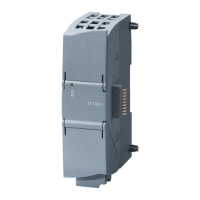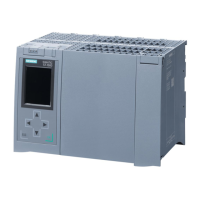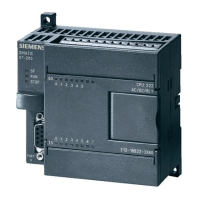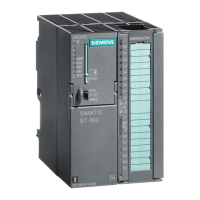Communication
11.2 PROFINET
S7-1200 Programmable controller
System Manual, V4.2, 09/2016, A5E02486680-AK
863
Table 11- 24 Data types for the parameters of TSEND and TRCV
REQ IN Bool TSEND: Starts the send job on a rising edge. The data is trans-
ferred from the area specified by DATA and LEN.
EN_R
IN Bool TRCV: Enables the CPU to receive; with EN_R = 1, the TRCV is
ready to receive. The receive job is processed.
ID IN CONN_OUC
(Word)
Reference to the associated connection. ID must be identical to
the associated parameter ID in the local connection description.
Value range: W#16#0001 to W#16#0FFF
LEN IN UDInt Maximum number of bytes to be sent (TSEND) or received
(TRCV):
• Default = 0: The DATA parameter determines the length of the
data to be sent (TSEND) or received (TRCV).
• Ad hoc mode = 65535: A variable length of data is set for re-
ception (TRCV).
ADHOC
IN Bool TRCV: Optional parameter (hidden)
Ad hoc mode request for connection type TCP.
DATA IN_OUT Variant Pointer to send (TSEND) or receive (TRCV) data area; data area
contains the address and length. The address refers to I memory,
Q memory, M memory, or a DB.
DONE OUT Bool TSEND:
• 0: Job not yet started or still running.
• 1: Job executed without error.
NDR OUT Bool TRCV:
• NDR = 0: Job not yet started or still running.
• NDR = 1: Job successfully completed.
BUSY OUT Bool
• BUSY = 1: The job is not yet complete. A new job cannot be
triggered.
• BUSY = 0: Job is complete.
ERROR OUT Bool ERROR = 1: Error occurred during processing. STATUS provides
detailed information on the type of error
STATUS OUT Word Status information including error information. (Refer to the Error
and Status condition codes in the table below.)
TRCV: Amount of data actually received in bytes
Note
The TSEND instruction requires a low
-to-high transition at the REQ input parameter to start
a send job. The BUSY parameter is then set to 1 during processing. Completion of the send
job is indicated by either t
he DONE or ERROR parameters being set to 1 for one scan.
During this time, any low
-to-high transition at the REQ input parameter is ignored.

